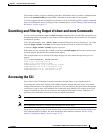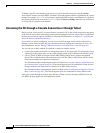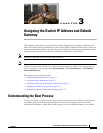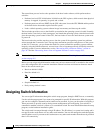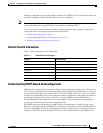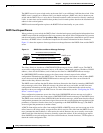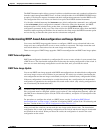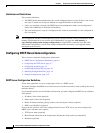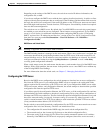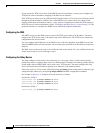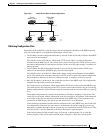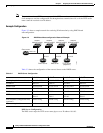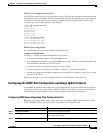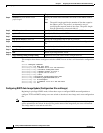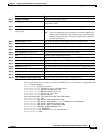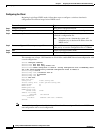
3-7
Catalyst 2960 and 2960-S Switch Software Configuration Guide
OL-8603-09
Chapter 3 Assigning the Switch IP Address and Default Gateway
Assigning Switch Information
Depending on the settings of the DHCP server, the switch can receive IP address information, the
configuration file, or both.
If you do not configure the DHCP server with the lease options described previously, it replies to client
requests with only those parameters that are configured. If the IP address and the subnet mask are not in
the reply, the switch is not configured. If the router IP address or the TFTP server name are not found,
the switch might send broadcast, instead of unicast, TFTP requests. Unavailability of other lease options
does not affect autoconfiguration.
The switch can act as a DHCP server. By default, the Cisco IOS DHCP server and relay agent features
are enabled on your switch but are not configured. These features are not operational. If your DHCP
server is a Cisco device, for additional information about configuring DHCP, see the “Configuring
DHCP” section of the “IP Addressing and Services” section of the Cisco IOS IP Configuration Guide
from the Cisco.com page under Documentation > Cisco IOS Software > 12.2 Mainline >
Configuration Guides.
DHCP Server and Switch Stacks
Note Stacking is supported only on Catalyst 2960-S switches.
The DHCP binding database is managed on the stack master. When a new stack master is assigned, the
new master downloads the saved binding database from the TFTP server. If the stack master fails, all
unsaved bindings are lost. The IP addresses associated with the lost bindings are released. You should
configure an automatic backup by using the ip dhcp database url [timeout seconds | write-delay
seconds] global configuration command.
When a stack merge occurs, the stack master that becomes a stack member loses all of the DHCP lease
bindings. With a stack partition, the new master in the partition acts as a new DHCP server without any
of the existing DHCP lease bindings.
For more information about the switch stack, see Chapter 7, “Managing Switch Stacks.”
Configuring the TFTP Server
Based on the DHCP server configuration, the switch attempts to download one or more configuration
files from the TFTP server. If you configured the DHCP server to respond to the switch with all the
options required for IP connectivity to the TFTP server, and if you configured the DHCP server with a
TFTP server name, address, and configuration filename, the switch attempts to download the specified
configuration file from the specified TFTP server.
If you did not specify the configuration filename, the TFTP server, or if the configuration file could not
be downloaded, the switch attempts to download a configuration file by using various combinations of
filenames and TFTP server addresses. The files include the specified configuration filename (if any) and
these files: network-config, cisconet.cfg, hostname.config, or hostname.cfg, where hostname is the
switch’s current hostname. The TFTP server addresses used include the specified TFTP server address
(if any) and the broadcast address (255.255.255.255).
For the switch to successfully download a configuration file, the TFTP server must contain one or more
configuration files in its base directory. The files can include these files:
• The configuration file named in the DHCP reply (the actual switch configuration file).
• The network-confg or the cisconet.cfg file (known as the default configuration files).
• The router-confg or the ciscortr.cfg file (These files contain commands common to all switches.
Normally, if the DHCP and TFTP servers are properly configured, these files are not accessed.)



